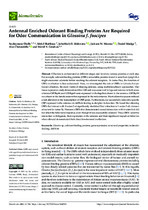| dc.contributor.author | Diallo, Souleymane | |
| dc.contributor.author | Shahbaaz, Mohd | |
| dc.contributor.author | Makwatta, JohnMark O. | |
| dc.date.accessioned | 2021-10-18T11:50:59Z | |
| dc.date.available | 2021-10-18T11:50:59Z | |
| dc.date.issued | 2021 | |
| dc.identifier.citation | Diallo, S. et al. (2021). Antennal enriched odorant binding proteins are required for odor communication in glossina f. Fuscipes. Biomolecules, 11(4), 541. https://doi.org/10.3390/biom11040541 | en_US |
| dc.identifier.issn | 2218-273X | |
| dc.identifier.uri | https://doi.org/10.3390/biom11040541 | |
| dc.identifier.uri | http://hdl.handle.net/10566/6923 | |
| dc.description.abstract | Olfaction is orchestrated at different stages and involves various proteins at each step.
For example, odorant-binding proteins (OBPs) are soluble proteins found in sensillum lymph that
might encounter odorants before reaching the odorant receptors. In tsetse flies, the function of
OBPs in olfaction is less understood. Here, we investigated the role of OBPs in Glossina fuscipes
fuscipes olfaction, the main vector of sleeping sickness, using multidisciplinary approaches. Our
tissue expression study demonstrated that GffLush was conserved in legs and antenna in both sexes,
whereas GffObp44 and GffObp69 were expressed in the legs but absent in the antenna. GffObp99
was absent in the female antenna but expressed in the male antenna. Short odorant exposure induced
a fast alteration in the transcription of OBP genes. Furthermore, we successfully silenced a specific
OBP expressed in the antenna via dsRNAi feeding to decipher its function. | en_US |
| dc.language.iso | en | en_US |
| dc.publisher | MPDI | en_US |
| dc.subject | Glossina species | en_US |
| dc.subject | Odorant-binding proteins | en_US |
| dc.subject | Gene expression | en_US |
| dc.subject | Structural properties | en_US |
| dc.subject | Flies | en_US |
| dc.title | Antennal enriched odorant binding proteins are required for odor communication in glossina f. Fuscipes | en_US |
| dc.type | Article | en_US |

